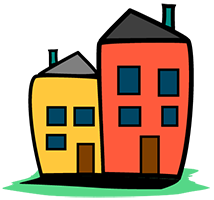For people with disabilities to live and participate as full and equal citizens in the community they must have somewhere to leave from and return to. This place is where we call home, whether it’s a single family home, a townhouse, a duplex, or an apartment. Finding accessible and affordable housing is a major concern for people with disabilities and centers for independent living work closely with their consumers to help find such housing. However, housing and the places we call home are about more than just shelter. In fact, the place we call home can have impacts on our health, quality of life, and ability to live independently.
An unusable home can present barriers to daily living that negatively impact an individual’s ability to fully participate in their community. Increased energy spent on overcoming usability problems in the home (such as limited kitchen or bathroom access) can reduce time and energy for additional life pursuits such as employment, socialization, and even relaxation.
In addition, unusable homes can contribute to an increased need for personal assistance or support services. By eliminating home usability problems, time and energy can be made available for the individual (independently and/or with personal assistance) to engage in activities beyond basic needs.
- Why Home Matters: This fact sheet outlines the core values and mission of the project. This will help educate potential members about the usability issues people face in their homes.
- Tailored Messages Templates: It is valuable to tailor your recruitment message to your audience. This document provides some concise messaging for different community members.
One of the fundamental principles of the Home Usability Network is to ensure that the process remains “consumer-driven.” This means that the person with the disability, a family member, or some other person designated by the disabled person is the one who:
- Starts the process—they make initial contact with the Center for Independent Living (CIL).
- Directs the process—to the extent they are comfortable with knowing the options, they decide what it is they want done. This does not exclude the input of the CIL staff person or any other people who may have expertise to offer, especially if it is information not known by the consumer.
- Monitors the process—the consumer makes sure the process is done in the way they want and in a timely and efficient manner. Again, some of this may be beyond the individual’s control or knowledge base so assistance may be provided by the CIL staff, friends, or family.
- Evaluates the process—did the person get what he or she wanted, or better? The consumer is the one who best determines this.
Having a home space that suits your needs is one of the most important steps to living independently. Home usability and independent living skills go hand in hand. In a way, home is where it all begins.
All of the basic Activities of Daily Living (ADLS) and many of the Instrumental Activities of Daily Living (IADLS), such as bathing, dressing, preparing meals, and housework take place within the home. Other independent living skills, such as taking care of pets or service animals, doing laundry, managing personal assistance, and even shopping for groceries are closely linked to home usability.
It is difficult to prepare meals, particularly healthy meals, in an unusable kitchen. Proper hygiene can be difficult to maintain when getting in and out of the bathtub is difficult and perhaps dangerous. Doing laundry can be next to impossible if the communal laundry room is inaccessible.
For people who use personal assistance services a usable home can increase the efficiency and safety of services provided, thereby making them more effective. In fact, home usability can be viewed as an integral step for increasing independence for all people.
- AHS Facsheet: This fact sheet compiled by the University of Montana and the University of Kansas highlights data from the 2011 American Housing Survey (AHS). The fact sheet shows the high rates of inaccessibility for renters with mobility impairments throughout the United States.
- Check out this factsheet from the American Housing Survey on home accessibility and access needs across the United States
- Use RTC:Rural’s Disability Counts data tool to access data on people with disabilities in the counties that you serve. This can be helpful when communicating needs to potential community partners.
The home usability program is part of a line of research on housing for people with disabilities undertaken through a partnership between the Universities of Kansas and Montana. The Home Usability Program itself has been tested at CILs in communities across the country. Nearly 200 consumers have gone through the program and been evaluated for outcomes related to community participation and improved experiences within their homes. Below are some publications, factsheets and presentations that highlight some of these research findings.
Peer reviewed articles:
- Life Starts at Home: Bathing, Exertion and Participation for People with Mobility Impairment
- A usable home: A qualitative investigation of the relationship between home usability and community participation for people with disabilities
- Effects of a consumer driven home modification intervention on community participation for people with mobility impairments
- “Home Usability to Support Community Living”, a presentation at the Association of Programs for Rural Independent Living (APRIL)’s annual meeting, 2021
- Two presentations on research results related to home usability at the Research and Training Center on Promoting Interventions for Community Living (RTC:PICL) State of the Science Conference2
- “Home Usability Program” (starts 45:41)
- “A Usable Home” (starts 41:08)
- “Home Usability to Support Community Living”, presented at the National Council on Independent Living (NCIL)’s Community Living Summit, 2022
- “The Home Usability Network”, presented at the Research and Training Center on Community Living State of the Science Conference, Washington DC, 2017

